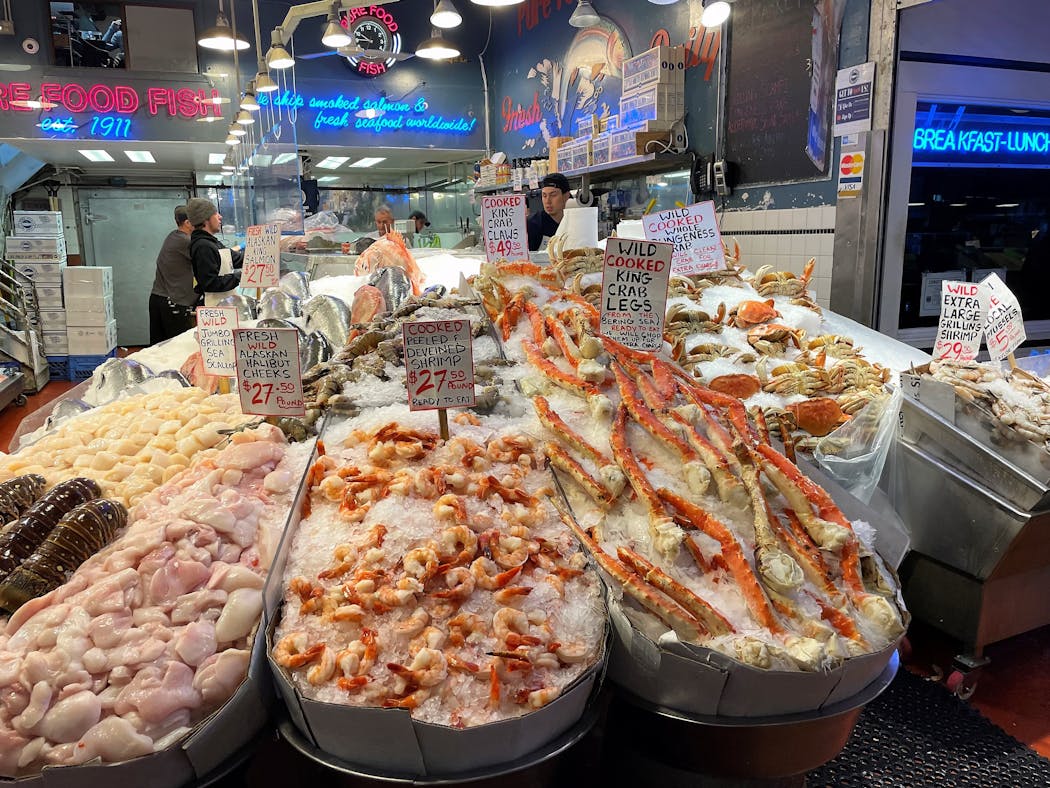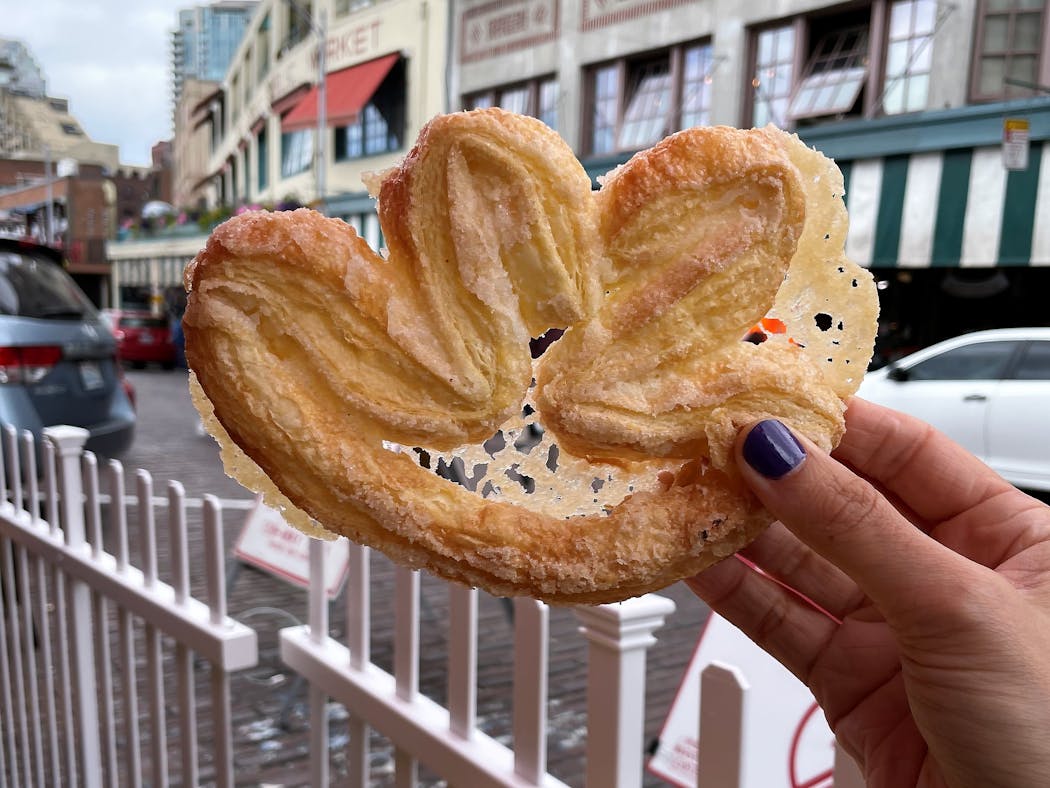The riotous colors, the din of voices, the smell of fish: After a year-plus spent mostly at home during the pandemic, I welcomed the sensory overload of Seattle's Pike Place Market.
Meandering through its passageways, you can buy a bouquet, admire handmade jewelry, eat gelato, browse through stacks of vintage magazine ads, and put a few coins into a machine to have your fortune told by a robotic chicken. The market encapsulates all of the spontaneous and unexpected things I had missed the most about travel.
As it is for most visitors to Seattle, the Pike Place Market was a must on our itinerary. However, we didn't anticipate that the market (which was saved from destruction 50 years ago this November) would become the focal point of our vacation. It's easy to spend days exploring the place — Pike Place Market encompasses 24 buildings sprawled across nine acres and is home to over 500 businesses, ranging from local farmers and artists to retailers, restaurants and a boutique hotel.
Pike Place Market was founded in 1907, in an effort to lower food prices by enabling farmers to sell their produce directly to consumers. It was expanded throughout the 1910s and early 1920s, when many of its historic buildings were constructed. During World War II, the market lost the majority of its farmers when they were interned due to their Japanese heritage; many of them never returned. Postwar, a population shift to the suburbs and the popularity of grocery stores took a toll, and market buildings deteriorated.
By 1963, the mayor and other local politicians were backing a plan to replace most of the Pike Place Market with skyscrapers. The grassroots Friends of the Market rallied to preserve the place, citing its historical importance and role in the community. Thanks to their efforts, Seattle voters approved a ballot initiative to "Keep the Market" on Nov. 2, 1971.
Timeless comfort
In the five decades since, the market has constantly evolved, including the recent addition of safety measures due to the pandemic. However, during my July trip to Seattle, the Pike Place Market provided a comforting sense of timelessness — the layout hasn't really changed since 1922, and many vendors have been around for decades.
Generations of customers and tourists have wandered the Main Arcade for the quintessential market experience: salmon chilling atop heaps of crushed ice, technicolor bouquets of flowers, and carefully arranged displays of fruits and vegetables. This is where the fishmongers famously throw the fish (you can't miss the crowd around the Pike Place Fish stall), but for me, the appeal is the fresh fruit. It was cherry season, and every day I bought a cup of Rainier cherries that tasted like juicy pops of sunshine.
One day, we browsed the shelves at DeLaurenti Specialty Food and Wine, founded in 1946. Today they stock over 200 cheeses, cured meats, artisan chocolates, fresh pasta and more. The store also has a cafe and espresso bar, where my partner opted for a sandwich loaded with salami, pepperoni and provolone.
My lunch pick was Piroshky Piroshky, which has been serving sweet and savory Russian hand pies since 1992. Each has a distinctive shape, from the fish-shaped smoked salmon pate piroshky to a roll with cutouts that reveal a chocolate hazelnut filling. Thanks to the efficient staff, the line moves much more quickly than the intimidating queue at the original Starbucks next door. My potato and cheese piroshky was comfort food at its finest, a compact portion of carbohydrates to fuel an afternoon of exploring.
Throughout our stay in Seattle, we visited Pike Place Market again and again, finding any excuse to stop by for a snack or a souvenir. One afternoon I savored an overflowing cup of marionberry yogurt from Ellenos Real Greek Yogurt, with lightly sweetened purple berries swirled into an extra-creamy, slightly tangy base.
Another favorite was Shug's Soda Fountain & Ice Cream (despite the old-fashioned vibe, it opened in 2016). Syrups and toppings are housemade, and the small-batch premium ice cream is sourced from a local creamery. The brownie sundae — loaded with hot fudge, whipped cream and rainbow sprinkles — was a sugary delight.
Stability and resilience
Fittingly, our final meal in Seattle was at Matt's in the Market. Tucked into the top floor of the Corner Market building, the upscale restaurant pairs locally sourced ingredients with global influences, like clams and mussels cooked in a fragrant broth of coconut milk, lime, Thai basil and chili flakes. Our table was next to a window that offered a view of the iconic neon "Public Market Center" sign, and we gazed down on the hubbub below.
Afterwards, we wandered through the market one more time, in search of dessert. My partner got some gelato from Bottega Italiana. I stopped by Three Girls Bakery.
Established in 1912, Three Girls Bakery was the first Seattle business licensed to women; it's also the Pike Place Market's oldest continuously operating business. The loaves of bread and poppy seed rugelach would probably look familiar to early market patrons, while the giant M&M cookies and vegan palmiers nod to current tastes.
But those delicate, sugar-encrusted vegan palmiers are still flavored by the past. Three Girls Bakery — and the farmers selling cherries, and the guys throwing fish, and even the line winding out of the door at Starbucks — gave me a much-needed sense of stability in an uncertain time. Thanks to the generations of people who have cared for it, Pike Place Market has endured for 114 years. Yes, I loved the food. But witnessing the resilience was the nourishment that I needed the most.
Stacy Brooks is a Minneapolis-based food and travel writer. She blogs at tangledupinfood.com.



